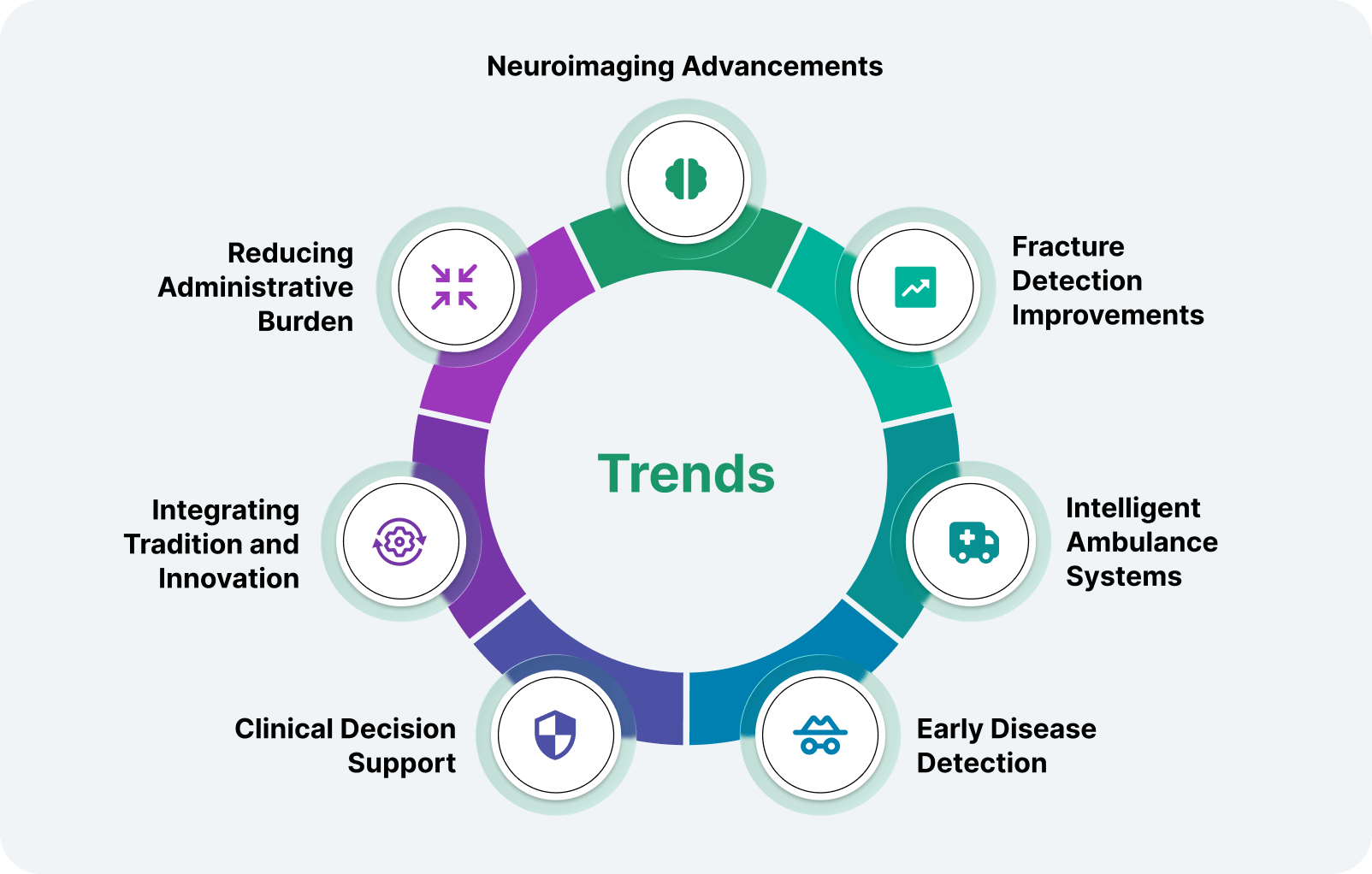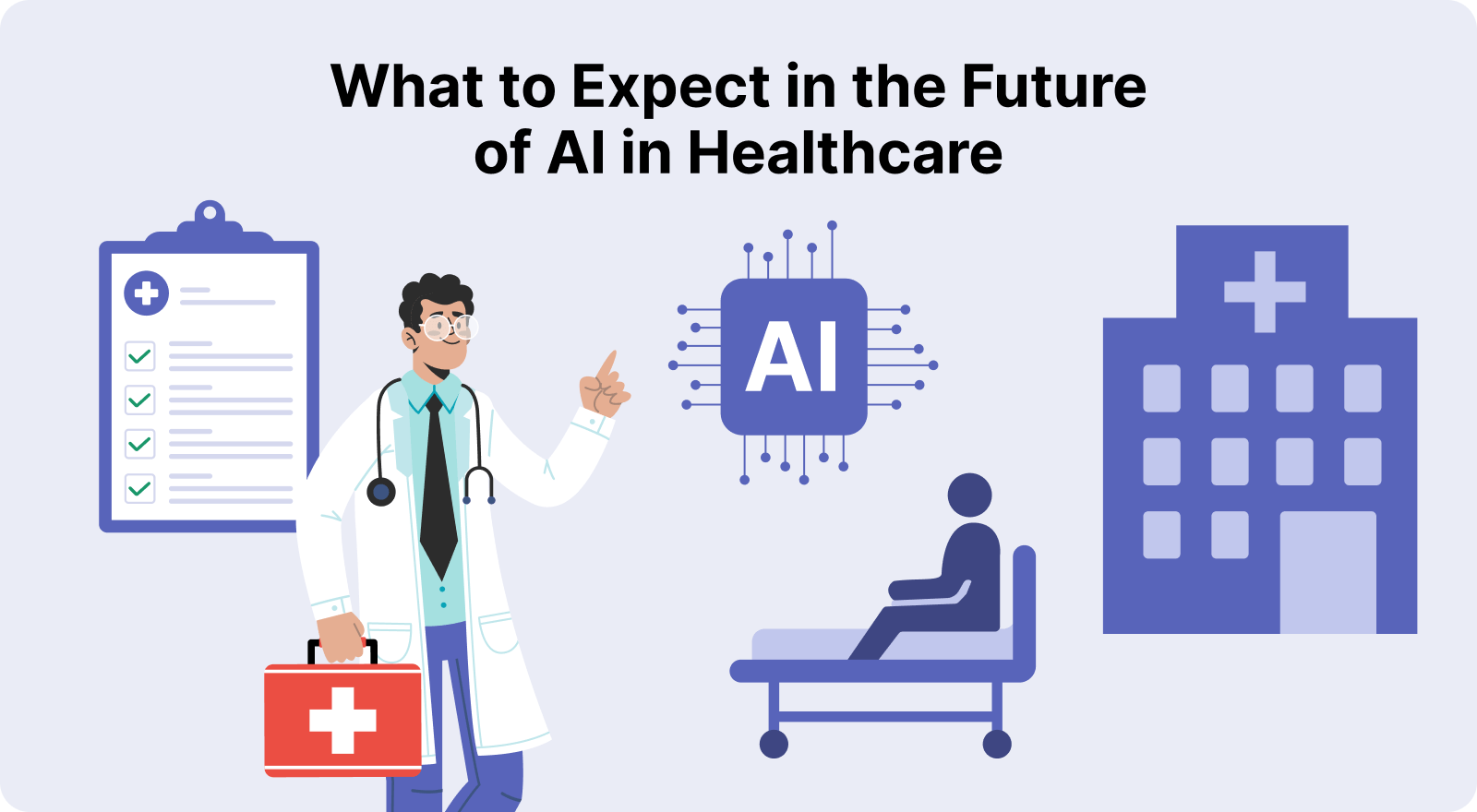AI trends in healthcare are increasingly focused on addressing systemic inefficiencies, including the administrative burdens that impact physician productivity. The global AI in healthcare market was valued at approximately $26.57 billion in 2024 and is projected to reach $36.79 billion by 2026.
For practicing physicians, the key concerns are practical. They want to know whether AI can actually reduce the time spent on documentation, improve patient flow without affecting the quality of care, and what the realistic timeline is for integrating these tools across different medical specialties.

In this article, we will dive into the key trends in AI healthcare in 2026, explore the advantages and challenges they bring, and share practical insights to help you navigate these emerging opportunities with confidence.
Only a short time ago, AI in healthcare future trends felt like an experiment, a promising concept waiting to prove its worth. Fast forward to 2026, and the picture looks entirely different. Many organizations have moved beyond testing ideas and are now putting them into everyday use. Most of the industry leaders are already running live projects, with more companies in the rollout phase than in early proof-of-concept stages. That shift demonstrates that what once seemed like a trial is quickly becoming standard practice.
Still, not everyone has joined the race. About 15% of organizations admit they haven’t yet started exploring use cases. While that might not sound alarming, hesitation could carry a cost. Early movers are already learning, improving, and seeing measurable returns, leaving slower competitors struggling to catch up.
What’s especially intriguing is how these technologies are being adopted. Instead of trying to build everything from scratch, most companies are choosing to team up with experienced partners. Around six in ten prefer collaboration with specialized vendors to create custom-built applications, while smaller groups focus on end-to-end healthcare software development or ready-made tools. Many are also turning to major cloud providers for their deep technical expertise and scalable infrastructure a partnership model that’s helping speed up progress across the industry.
The range of practical uses keeps expanding, too. The strongest impact so far has been seen in administrative tasks and clinical support, where automation and intelligent processing reduce manual work and free up professionals for higher-value tasks. Others are finding success in improving communication, coordination, and overall system efficiency, proof that the potential goes far beyond one department or function.
Even more encouraging, organizations are starting to measure their progress. Nearly two-thirds of those already using generative tools say they’re seeing or confidently expect positive returns on investment.

Walk into any modern hospital today, and you can sense the change. Screens display real-time insights, algorithms lend a hand in diagnosis, and digital systems are starting to anticipate what patients need before they even ask. The once distant idea of EHR software is now part of everyday reality, quietly transforming how professionals work, think, and care.
In just a few years, cautious experimentation has turned into confident adoption. Intelligent systems are helping create better treatment plans, predict potential risks, and give teams more time to focus on people instead of paperwork.
Amid this rapid progress, the real question is which AI in healthcare trends truly deserves attention. The following overview explores the modern developments, highlighting those that go beyond early promise and are already changing the way medicine is practiced.
Researchers in the United Kingdom have developed a system that can interpret brain scans with remarkable precision, reportedly performing twice as accurately as human specialists. Trained on 800 stroke cases and tested on 2000 more, it analyzed brain images and identified when the stroke occurred, a key factor in determining appropriate treatment. Understanding that timeline is critical, as it helps professionals decide which therapies remain effective and when recovery becomes less likely.
Fractures often go unnoticed in emergency departments, partly due to heavy workloads and staff shortages. Automated imaging tools are helping to reduce that risk by detecting breaks that might otherwise be missed. The National Institute for Health and Care Excellence in the UK has confirmed the reliability of these systems, noting their potential to lower the number of unnecessary scans and follow-up appointments. Still, experts emphasize that professionals need proper training to understand both the benefits and the limits of healthcare AI market trends before it is adopted on a larger scale.
Every month, hundreds of thousands of people are transported by ambulance, and deciding who truly needs to go to the hospital is a complex and urgent task. In this context, healthcare software development could accurately assess which individuals typically require transfer to a hospital by analyzing information such as mobility, pulse, and oxygen levels. Early results show promise, but researchers highlight the importance of continued evaluation and responsible implementation.
A conversational AI for healthcare solutions developed by a global biopharmaceutical company has demonstrated the ability to detect the early signs of more than a thousand chronic diseases, often long before symptoms appear. Using information from hundreds of thousands of individuals, the system can anticipate conditions such as Alzheimer’s, kidney disease, and chronic lung disorders years in advance.
Another research project has shown that an image recognition model can successfully detect epilepsy-related brain lesions that were previously missed in manual scans. It can identify even the smallest and most obscured irregularities, allowing experts to make faster and more confident diagnoses when paired with human review.
New conversational systems are being tested to support professionals in making quick, informed medical decisions. While general-purpose chatbots often fall short in reliability, monetizing AI diagnoses that combine language processing with evidence-based retrieval mechanisms shows encouraging results.
Digital triage platforms are also being adopted to simplify case management and reduce workload. Studies have shown that these tools can cut readmission rates and shorten the time professionals spend reviewing records, allowing them to focus more on direct care.
Traditional medicine continues to play a major role in health systems across the world. Evidently AI healthcare software solutions can strengthen, rather than replace, long-standing healing practices. A global health organization has reported projects where these systems are being used to digitize ancient medical texts, identify medicinal plants, and analyze traditional remedies for potential new treatments.
At the same time, experts stress the need to protect cultural heritage and ensure that innovation benefits local communities rather than exploiting them. Ethical oversight and collaboration are essential as traditional knowledge enters the digital space.
Administrative work remains one of the most time-consuming aspects of medical practice. Digital assistants designed to listen to consultations and generate records automatically are already being tested to ease that burden. Early adopters report that these tools can significantly reduce documentation time and accelerate testing processes, helping professionals redirect attention toward more meaningful tasks.
Public confidence in such systems, however, is still developing. Many people prefer technology to support professionals rather than replace their judgment. Regulators in both Europe and the United States continue to monitor this field closely to ensure that new technologies remain transparent, effective, and safe.

When implemented thoughtfully, digital intelligence brings automation and convenience, reshaping how care is delivered, how teams collaborate, and how decisions are made. For organizations ready to adapt, the rewards can be significant.
Greater Accuracy in Clinical Decisions
Intelligent systems sift through mountains of medical information, spotting patterns that can easily be missed. This means you can make quicker, smarter decisions and feel confident that nothing critical slips through the cracks. Over time, these insights help reduce uncertainty and support better outcomes across the board.
Endless scheduling, record-keeping, and follow-ups take a toll on your team. AI in healthcare business takes on these time-consuming tasks, giving your staff space to focus on work that truly matters, like direct care, strategy, and collaboration. With less clutter and more clarity, daily operations run smoother, and your team can dedicate energy where it counts most.
Predictive insights show exactly where attention, staff, and equipment are needed most. With AI healthcare companies, you can stay ahead of demand, avoid surprises, and make sure your resources are ready when and where they’re required. This foresight helps prevent bottlenecks, supports high-priority tasks, and keeps operations flowing seamlessly.
By spotting emerging trends of AI in healthcare early, technology flags risks before they escalate. You can intervene sooner, prevent bigger issues, and keep outcomes on track, making your approach more proactive and confident. Over time, the technology allows teams to monitor evolving conditions, adjust strategies quickly, and safeguard well-being with precision.
Less repetitive work and reliable support make a tangible difference. Your team feels less stressed, more focused, and better equipped to handle complex cases, while those you serve enjoy faster responses, smoother interactions, and a more personalized experience. The result is a workplace and environment where everyone benefits.
Analytical tools turn complex information into actionable insights at speed. New discoveries move into practice faster, enabling smarter decision-making and helping your organization stay ahead of trends in AI in healthcare. This continuous learning loop fuels innovation and keeps your team equipped to tackle challenges with confidence.

Introducing new artificial intelligence trends in healthcare into medical settings often sounds simpler than it is. Many organizations invest in digital tools expecting quick transformation, only to observe that technical, ethical, and organizational challenges slow down progress. To make adoption smoother and more effective, it is crucial to understand what can go wrong and how to prevent it before it happens.
Adopting advanced tools without a defined purpose often leads to wasted effort. Start with a focused problem to solve, whether it involves diagnostics, workflow optimization, or administrative efficiency, and align every step of the process with measurable goals.
Even the most sophisticated models rely on accurate, well-organized information. Incomplete or inconsistent records can distort outcomes and lead to unreliable insights. Regular audits and standardized input formats help maintain quality and consistency.
Tools perform best when people understand how to use them. Ongoing education ensures that clinicians, administrators, and IT teams feel confident using new systems, reducing errors and resistance to change.
Maintaining trust requires careful attention to how sensitive information is collected, stored, and applied. Transparent policies and strict compliance with local and international regulations safeguard both individuals and institutions.
Connecting new platforms with existing infrastructure can be complex. Early collaboration between technical teams and medical departments helps identify compatibility issues and prevent costly disruptions later.
Implementation does not end once a system goes live. Continuous evaluation ensures that performance remains consistent and that the healthcare AI trends continue to serve real operational needs as conditions evolve.

As the field evolves, it’s clear that the next few years will bring more than incremental improvements. The role of artificial intelligence in healthcare businesses is moving from isolated experiments to integrated, practical applications that touch nearly every part of the medical environment.

At Sandwell and West Birmingham NHS Trust, a new intelligent imaging system has transformed how strokes are diagnosed and treated. The GenAI in healthcare analyzes CT scans to detect abnormalities and alerts clinicians in real time, helping them make faster, more accurate decisions.
The impact has been remarkable. The average time from patient arrival to treatment dropped from 140 minutes to just 79 minutes, which is critical when every minute can affect recovery. Faster detection means that more patients receive timely interventions, significantly improving their chances of regaining normal function. In fact, the proportion of patients recovering with minimal or no long-term effects rose from 16% to 48%, effectively tripling recovery rates.
Clinicians report that the system has also reduced the pressure on staff by identifying hidden fractures and other urgent conditions that might have been missed during peak workloads. By supporting decision-making and prioritizing the most critical cases, the team can focus on direct care where human judgment is essential.
This example shows how AI in the healthcare industry can be thoughtfully integrated into clinical workflows. It does not replace expertise but complements it, helping professionals act faster, more confidently, and with better outcomes for the people they serve. Sandwell and West Birmingham NHS Trust sets a clear benchmark for what thoughtful adoption of advanced tools can achieve: faster treatment, improved recovery, and a more effective clinical environment overall.
The pace of change in the medical field is accelerating, and with it comes remarkable potential. Tools that once seemed experimental are now supporting professionals in everyday operations, helping them make faster, more confident decisions and focus on what truly matters. These technologies, ranging from advanced imaging and predictive models to digital assistants, are revolutionizing work processes and enabling teams to produce superior results more effectively.
For you, this means new opportunities to optimize resources, anticipate AI healthcare trends, and act proactively rather than reactively. Intelligent systems can spot patterns humans might miss, automate repetitive tasks, and free up valuable time for meaningful interactions. The result is smoother operations, greater accuracy, and an overall improvement in experience for both staff and those they serve.


Our newsletter is packed with valuable insights, exclusive offers, and helpful resources that can help you grow your business and achieve your goals.